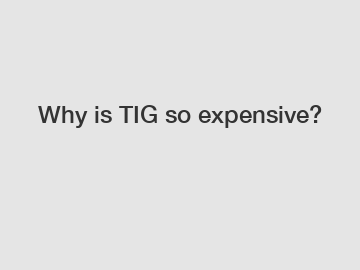Why is TIG so expensive?
Why is TIG so expensive?
Tungsten Inert Gas (TIG) welding, also known as Gas Tungsten Arc Welding (GTAW), is a popular welding process that offers numerous advantages, such as precision, versatility, and better control over the weld. However, these benefits come at a cost. TIG welding is generally more expensive compared to other welding processes. In this article, we will explore the reasons behind the high cost of TIG welding and discuss its significance and impact.
One of the primary reasons for the high cost of TIG welding is the equipment involved. TIG welding requires specialized equipment, including a TIG torch, power supply, gas flow regulators, and a shielding gas system. These components, along with the necessary safety equipment, can significantly contribute to the overall cost of setting up a TIG welding station.

Moreover, TIG welding relies on the use of inert gases, such as argon or helium, to create a protective atmosphere around the weld. These gases are relatively expensive compared to other welding gases. The continuous supply of high-quality shielding gas adds to the cost of TIG welding.
Another aspect that contributes to the expense of TIG welding is the requirement for highly skilled welders. TIG welding demands precision, dexterity, and a deep understanding of the welding process. The welder needs to control the heat input, filler wire, and torch positioning simultaneously, which requires extensive training and experience. The significant investment in skills and expertise contributes to the higher labor costs associated with TIG welding.
Additionally, TIG welding is commonly used for welding exotic and high-performance materials such as stainless steel, aluminum, and titanium. These materials are generally more expensive than traditional steel, making the cost of materials for TIG welding relatively higher. The specialized techniques required to weld these materials further add to the overall expense.
Despite its higher cost, TIG welding offers several significant advantages that justify its expense. The precise control over the heat input and the ability to weld thin materials without distortion or damage make TIG welding a preferred choice in industries where quality and precision are crucial, such as aerospace and automotive sectors.
Furthermore, the clean and aesthetically pleasing welds produced by TIG welding are highly valued in applications where the appearance of the weld is important. The absence of spatter and the minimal post-weld cleaning required contribute to cost savings in terms of labor and material.
In conclusion, the high cost of TIG welding can be attributed to the specialized equipment, expensive shielding gases, skilled labor, and the use of high-performance materials. However, the precision, versatility, and superior quality of TIG welding make it a preferred choice for applications where the benefits outweigh the cost. By understanding the reasons behind its expense, industries and professionals can make informed decisions regarding the utilization of TIG welding in their projects, ultimately leading to higher-quality outcomes.
Contact us to discuss your requirements of china wear plate, china chromium carbide overlay welding, china hardfacing. Our experienced sales team can help you identify the options that best suit your needs.


